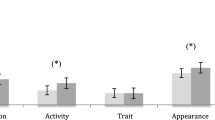Abstract
Thirty-nine items of sex-role stereotype questionnaire from Broverman's study were used as the instrument to get three separate responses — male stereotype, female stereotype, social desirability — from 340 college students. Half of the subjects were American, half Chinese. The number of male and female subjects was equal. The major findings were as follows: (1) In rating female sex-role stereotype, American subjects described the female sex-role with more agentic and competent attributes, while Chinese subjects tended to describe the female sex-role with more warm and expressive attributes. (2) In both nations, there was a tendency for males to emphasize the male stereotype as more socially desirable, while the female subjects did not. (3) In both nations, there was a tendency for women to describe the female stereotype differently from males' description (liberated image vs. traditional image).
Similar content being viewed by others
References
Bakan, D. The duality of human existence. Chicago: Rand McNally, 1966.
Barry, H., Child, I., & Bacon, M. Relation of child training to subsistence economy. American Anthropologist, 1959, 61, 51–63.
Block, J. H. Conceptions of sex roles: Some cross-cultural and longitudinal perspectives. American Psychologist, 1973, 28, 512–526.
Broverman, I. K., Broverman, D. M., Clarkson, F. E., Rosenkrantz, P. S., & Vogel, S. R. Sex-role stereotypes and clinical judgments of mental health. Journal of Consulting and Clinical Psychology, 1970, 34, 1–7.
Broverman, I. K., Vogel, S. R., Broverman, K. M., Clarkson, F. E., & Rosenkrantz, P. S. Sex-role stereotypes: A current appraisal. Journal of Social Issues, 1972, 28, 59–78.
D'Andrade, R. Cross-cultural studies of sex differences in behavior. In E. Maccoby (Ed.), The development of sex differences in behavior. Stanford: Stanford University Press, 1966.
Hetherington, E. M., & Parke, R. D. Child psychology, New York: McGraw-Hill, 1975.
Hsu, F. L. Americans and Chinese: Purpose and fullfillment in great civilization. Garden City, N.Y.: Natural History Press, 1970.
Mead, M. Sex and temperament in three primitive societies. New York: Morrow, 1935.
Poloman, M. M., & Garland, T. N. The married professional woman: A study in the tolerance of domestication. Journal of Marriage and the Family, 1971, 23, 531–540.
Rosenkrantz, P. S., Vogel, S. R., Bee, H., Broverman, I. K., & Broverman, D. M. Sex-role stereotypes and self-concepts in college students. Journal of Consulting and Clinical Psychology, 1968, 32, 287–295.
Stricker, G. Implications of Research for Psychotherapeutic treatment of women. American Psychologist. 1977, 14, 16–22.
Author information
Authors and Affiliations
Rights and permissions
About this article
Cite this article
Lii, SY., Wong, SY. A cross-cultural study on sex-role stereotypes and social desirability. Sex Roles 8, 481–491 (1982). https://doi.org/10.1007/BF00287714
Issue Date:
DOI: https://doi.org/10.1007/BF00287714



